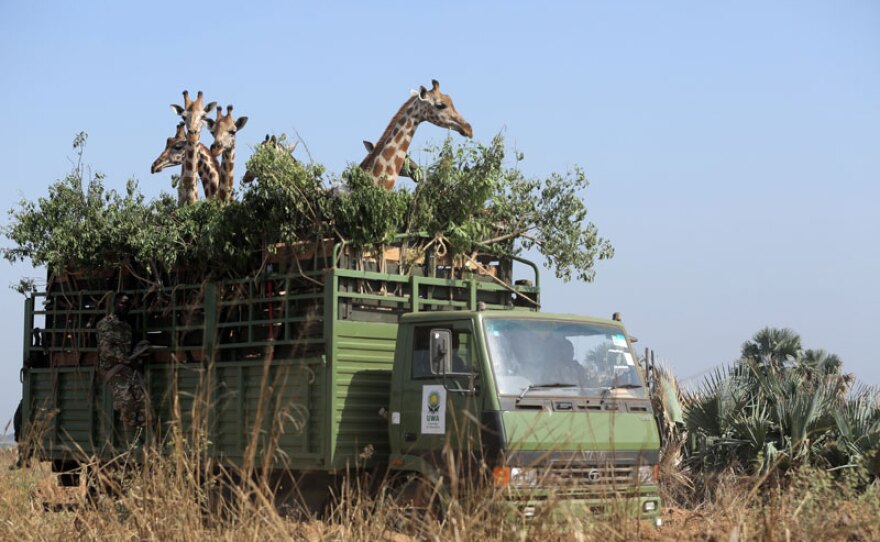Dr. Julian Fennessy leads a team to relocate the world’s rarest giraffes.
It’s ironic that the life of one of the world’s most identifiable and popular wild animals, the giraffe, is still something of a mystery. As these giants began to be studied, it was revealed that they don’t need to drink in the desert because they can get enough water just eating leaves.
Another important finding is the role giraffes play as pollinators and seed spreaders which is vital to maintaining healthy landscapes in many parts of Africa.
Much of what we know about these creatures is due to the work of Dr. Julian Fennessy, co-founder and co-director of Giraffe Conservation Foundation (GCF), who has been studying giraffes for over 20 years.
Fennessy has exposed the shocking fact that giraffe populations in Africa are down by 40 percent in just two decades, prompting the featured mission in the film to move a herd of rare Rothschild’s giraffes across the Nile River to a safer location.
“Giraffes: Africa’s Gentle Giants” originally aired in 2016 on PBS.

Dr. Julian Fennessy, an Australian, earned his PhD studying the tall beasts in the Namibian desert. He runs the GCF with wife Steph out of the family home in Windhoek, Namibia’s capital. They are parents to Molly, age seven, and Luca, age ten, who share the Fennessys’ love of giraffes.
They’ve learned the huge bumps on a giraffe’s head, called ossicones, are different from horns or antlers. They spot an old bull their parents studied before they were born and their dad estimates he may be the world’s oldest recorded wild giraffe at over 20 years old.
But with only 90,000 left, his goal is to identify which giraffes need urgent help based on his ground-breaking theory that there are four or five unique giraffe species, not just one.
As the film chronicles, Fennessy has to go to Ethiopia’s border with war-torn South Sudan to complete his collection of DNA samples from Africa’s wild giraffe population before he can run a species analysis.
Searching for Nubian giraffes by helicopter, he gets one sample before gunfire aimed at the copter ends a final day’s search for more.

It was Fennessy’s research that greatly contributed to the very recent genetic discovery which confirmed there indeed are four distinct species of giraffe: the northern giraffe, southern giraffe, reticulated giraffe, and the Masai giraffe.
This breaking news comes just as the world is learning of the endangered status of the giraffe and the need to preserve all four species.
Because a population in Uganda, called Rothchild’s giraffes, are the same type as the Nubian and are endangered due to poaching and oil drilling plans, Fennessy and the Uganda Wildlife Authority work out an ambitious plan to protect the species.

A team of Ugandan veterinarians and park rangers go through training in how to safely capture a herd of young, healthy females and a few males.
They guide them into trucks, drive four hours to the Nile River, cross via a ferry, and then release them in a safer habitat to breed far from the oil drilling.
The film captures all the drama of such a difficult and dangerous operation in Uganda’s Murchison Falls National Park as the Fennessys and the team hope a successful relocation will prompt more missions to protect these rare giraffes for generations.
WATCH ON YOUR SCHEDULE:
This episode is available for streaming on demand with KPBS Passport, video streaming for members ($60 yearly) using your computer, smartphone, tablet, Roku, AppleTV, Amazon Fire or Chromecast. Learn how to activate your benefit now.
CONNECT:
NATURE is on Facebook, Tumblr and you can follow @PBSNature on Twitter. #NaturePBS
The Giraffe Conservation Foundation is on Facebook, Instagram, and you can follow @Save_Giraffe on Twitter.
Giraffes: Africa's Gentle Giants
A population of rare Rothchild’s giraffes are endangered due to poaching and oil drilling plans in the African Nation of Uganda. Dr. Julian Fennessy and the Uganda Wildlife Authority work out an ambitious plan to protect the species.
CREDITS:
NATURE is a production of THIRTEEN PRODUCTIONS LLC for WNET. For NATURE, Fred Kaufman is executive producer. “Giraffes: Africa’s Gentle Giants” is an AGB Films production with Gripping Films for THIRTEEN Productions LLC and BBC in association with WNET. Narrated by Paul Christie.





